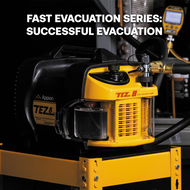Fast Evacuation Series: Successful Evacuation
Jun 11th 2024
Fast Evacuation Series: Successful Evacuation
Introduction: Decay Test
Verifying the system evacuation is the final and most important step of the process. The standard procedure for testing a system evacuation is a decay test. After the system's degassing and dehydration have been completed and the target vacuum level has been reached, the system and micron gauge need to be isolated. Check out the full-flow setup tips in our previous blog post to make this process simple.
Acceptable Rise
By closing the valve core removal tools on the system, we can test the system's ability to hold an isolated vacuum. Once the system is isolated, it must hold a vacuum for a specified time. During this window, the vacuum level can rise to a specified level. The length of time and micron level typically specified by the system manufacturer are jointly referred to as the acceptable rise. In the absence of a manufacturer's recommendation, refer to ASHRAE standards. If the system stays within the acceptable rise for the full duration of the decay test, this proves the system is clean, dry, and tight, signifying the evacuation was successful. It's important to note that you will typically see a rise in vacuum level. As long as it stays within the recommended range, it is an acceptable level of rise.
Rate of Acceptable Rise over Time
¼ in. Valve Core Removal Tool
AV760 Full-Range Vacuum Gauge
Unacceptable Rise: Incomplete Degassing/Dehydration, Contaminants, and Leaks
If the micron level climbs higher than the acceptable rise during the duration of the test, the evacuation is not finished. The micron gauge can still provide answers about the system's current state. As more time passes with the system still isolated, the micron gauge can indicate several issues, such as incomplete degassing or dehydration, contaminants inside the system, or a system leak.
If the system maintains a slow rise and eventually levels off at a relatively low micron level, this means that the system was not fully evacuated and is still equalizing. This will require continued evacuation. If the rise trend is similar but equalizes considerably higher, this indicates that there may be contaminants or moisture in the system, which may require a nitrogen sweep and a second evacuation.
If the rise trend is steady and doesn't appear to be slowing down, this indicates a system leak. With a system leak the micron level will rise consistently until reaching atmospheric pressure. The severity of the leak is directly related to the speed at which the level is rising. Leaks can vary from pinholes in the line set to missing port caps. Identifying and resolving the leak is the only way to address this issue.
Unacceptable Rise Scenarios Over Time
Again, it's normal to see a rise during a decay test. Using a full-range vacuum gauge will help you diagnose the vacuum and better understand what is happening inside the system. Once the issues have been addressed, another decay test must be performed. The evacuation is deemed successful if the system successfully passes the decay test.
Conclusion
In this series of blog posts, we've explained the importance of testing your tools and maintaining quality oil in your pump, along with the most effective vacuum setups to achieve full flow. You can now evacuate systems with confidence, knowing that you're pulling the fastest, quality vacuum you can.
Fast Evacuation Series // Part 5 - Successful Evacuation:

